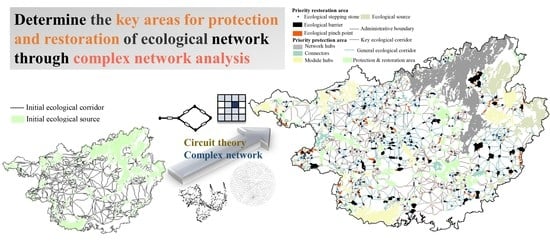How to Optimize High-Value GEP Areas to Identify Key Areas for Protection and Restoration: The Integration of Ecology and Complex Networks
Abstract
:1. Introduction
2. Study Area and Data Sources
2.1. Study Area
2.2. Data Sources
3. Methods
3.1. Ecological Network (EN) Construction
3.1.1. Selection of Ecological Source
3.1.2. Resistance Surface Construction
3.1.3. Identification of Ecological Corridor
3.2. Optimization of Ecological Network
3.3. Analysis of Complex Networks
3.3.1. Analysis of Network Topological Attributes
3.3.2. Calculation of Connectivity within Modules () and Connectivity between Modules ()
3.3.3. Network Robustness Evaluation
4. Results
4.1. Ecological Network Construction
4.1.1. Initial Ecological Source
4.1.2. Construction of Resistance Surface
4.1.3. Initial Ecological Corridor
4.2. Enhancement and Optimization of the Ecological Network
4.2.1. Optimization Strategy
4.2.2. Comparison of GEP before and after Optimization
4.3. Priority Areas for Protection and Restoration
4.3.1. Module Connectivity Calculation
4.3.2. Priority Areas for Protection and Restoration
4.4. Complex Network Analysis
4.4.1. Analysis of Network Topology before and after Optimization
4.4.2. Comparison of Network Anti-Attack Ability before and after Optimization
5. Discussion
5.1. Designing Biodiversity Protection Measures in Combination with an Ecological Network
5.2. Identification of Protection Priority Areas and Key Corridors
5.3. Using the Insight of Protection Strategies in Future Planning
5.4. Optimization Strategy
5.5. Research on Existing Uncertainties and Problems
6. Conclusions
- (1)
- There are 456 original ecological sources in Guangxi, based on GEP extraction, with a total area of 51,860.55 km2, which represents 41.93% of the GEP in Guangxi. The northeast and the mountainous regions of the southwest are where the majority of the sources are found. There are 1219 ecological corridors, 168 ecological barriers, 83 ecological pinch points, and 71 stepping stones connecting patches in ecological source areas.
- (2)
- There are 778 ecological sources after optimization, and the attached GEP value reaches USD 163.78 billion, an increase of 13.33% compared with that before optimization. The area was increased by 22,090 km2. After optimization, there are 2078 ecological corridors with a combined length of 23,922.07 km, which improves the distribution of the corridors’ complexity and increases the network’s overall density.
- (3)
- The priority areas for protection are distributed throughout a large area, with a total area of 50,869.97 km2 and a GEP of USD 118 billion. The priority areas for restoration are scattered throughout small patches, with a total area of 22,090 km2 and a GEP of USD 19.27 billion. In addition, 1018 key ecological corridors were identified, with a total length of 12,537.91 km.
- (4)
- Taking patches of ecological sources as nodes and corridors as edges, the complex network analysis shows that the optimized network connectivity and information transmission ability are improved, and the robustness of edge recovery, node recovery, and connection are improved. Among them, the improvement in robustness under random attack is the most remarkable.
Author Contributions
Funding
Data Availability Statement
Conflicts of Interest
References
- Li, G.; Fang, C.; Li, Y.; Wang, Z.; Sun, S.; He, S.; Qi, W.; Bao, C.; Ma, H.; Fan, Y.; et al. Global impacts of future urban expansion on terrestrial vertebrate diversity. Nat. Commun. 2022, 13, 1628. [Google Scholar] [CrossRef] [PubMed]
- Lefcheck, J.S.; Byrnes, J.E.K.; Isbell, F.; Gamfeldt, L.; Griffin, J.N.; Eisenhauer, N.; Hensel, M.J.S.; Hector, A.; Cardinale, B.J.; Duffy, J.E. Biodiversity enhances ecosystem multifunctionality across trophic levels and habitats. Nat. Commun. 2015, 6, 6936. [Google Scholar] [CrossRef] [PubMed] [Green Version]
- Walden, E.; Queiroz, C.; Plue, J.; Lindborg, R. Biodiversity mitigates trade-offs among species functional traits underpinning multiple ecosystem services. Ecol. Lett. 2023, 26, 929–941. [Google Scholar] [CrossRef] [PubMed]
- Ferreira, H.M.; Magris, R.A.; Floeter, S.R.; Ferreira, C.E.L. Drivers of ecological effectiveness of marine protected areas: A meta-analytic approach from the Southwestern Atlantic Ocean (Brazil). J. Environ. Manag. 2022, 301, 113889. [Google Scholar] [CrossRef]
- De Souza, A.C.; Prevedello, J.A. The importance of protected areas for overexploited plants: Evidence from a biodiversity hotspot. Biol. Conserv. 2020, 243, 108482. [Google Scholar] [CrossRef]
- Ghosh-Harihar, M.; An, R.; Athrey, R.; Borthakur, U.; Chanchani, P.; Chetry, D.; Datta, A.; Harihar, A.; Karanth, K.K.; Mariyam, D.; et al. Protected areas and biodiversity conservation in India. Biol. Conserv. 2019, 237, 114–124. [Google Scholar] [CrossRef]
- Ma, T.; Lu, C.; Lei, G. The spatial overlapping analysis for Chinas natural protected area and countermeasures for the optimization and integration of protected area system. Biodivers. Sci. 2019, 27, 758–771. [Google Scholar]
- Puri, M.; Srivathsa, A.; Karanth, K.K.; Patel, I.; Kumar, N.S. Links in a sink: Interplay between habitat structure, ecological constraints and interactions with humans can influence connectivity conservation for tigers in forest corridors. Sci. Total Environ. 2022, 809, 151106. [Google Scholar] [CrossRef]
- Diniz, M.F.; Coelho, M.T.P.; Sánchez-Cuervo, A.M.; Loyola, R. How 30 years of land-use changes have affected habitat suitability and connectivity for Atlantic Forest species. Biol. Conserv. 2022, 274, 109737. [Google Scholar] [CrossRef]
- Pearson, R.G.; Connolly, N.M.; Davis, A.M.; Brodie, J.E. Fresh waters and estuaries of the Great Barrier Reef catchment: Effects and management of anthropogenic disturbance on biodiversity, ecology and connectivity. Mar. Pollut. Bull. 2021, 166, 112194. [Google Scholar] [CrossRef]
- Cunha, N.S.; Magalhaes, M.R. Methodology for mapping the national ecological network to mainland Portugal: A planning tool towards a green infrastructure. Ecol. Indic. 2019, 104, 802–818. [Google Scholar] [CrossRef]
- Lu, Y.; Liu, Y.; Xing, L.; Liu, Y. Robustness test of multiple protection strategies for ecological networks from the perspective of complex networks: Evidence from Wuhan Metropolitan Area, China. Land Degrad. Dev. 2023, 34, 52–71. [Google Scholar] [CrossRef]
- Chen, D.; Lan, Z.; Li, W. Construction of Land Ecological Security in Guangdong Province From the Perspective of Ecological Demand. J. Ecol. Rural Environ. 2019, 35, 826–835. [Google Scholar]
- Huang, X.; Cao, X.; Zhang, M.; Zou, X. Construction of Landscape Ecological Security Pattern of Shengli Coalfield in Inner Mongolia Based on the Minimum Cumulative Resistance Model. J. Ecol. Rural Environ. 2019, 35, 55–62. [Google Scholar]
- Tong, H.L.; Shi, P.J. Using ecosystem service supply and ecosystem sensitivity to identify landscape ecology security patterns in the Lanzhou-Xining urban agglomeration, China. J. Mt. Sci. 2020, 17, 2758–2773. [Google Scholar] [CrossRef]
- Chen, N.N.; Kang, S.Z.; Zhao, Y.H.; Zhou, Y.J.; Yan, J.; Lu, Y.R. Construction of ecological network in Qinling Mountains of Shaanxi, China based on MSPA and MCR model. Ying Yong Sheng Tai Xue Bao J. Appl. Ecol. 2021, 32, 1545–1553. [Google Scholar] [CrossRef]
- Cui, L.; Wang, J.; Sun, L.; Lv, C. Construction and optimization of green space ecological networks in urban fringe areas: A case study with the urban fringe area of Tongzhou district in Beijing. J. Clean. Prod. 2020, 276, 124266. [Google Scholar] [CrossRef]
- Zhao, S.M.; Ma, Y.F.; Wang, J.L.; You, X.Y. Landscape pattern analysis and ecological network planning of Tianjin City. Urban For. Urban Green. 2019, 46, 126479. [Google Scholar] [CrossRef]
- Qiu, S.; Fang, M.; Yu, Q.; Niu, T.; Liu, H.; Wang, F.; Xu, C.; Ai, M.; Zhang, J. Study of spatialtemporal changes in Chinese forest eco-space and optimization strategies for enhancing carbon sequestration capacity through ecological spatial network theory. Sci. Total Environ. 2023, 859, 160035. [Google Scholar] [CrossRef]
- Qiu, S.; Yu, Q.; Niu, T.; Fang, M.; Guo, H.; Liu, H.; Li, S.; Zhang, J. Restoration and renewal of ecological spatial network in mining cities for the purpose of enhancing carbon Sinks: The case of Xuzhou, China. Ecol. Indic. 2022, 143, 109313. [Google Scholar] [CrossRef]
- Kong, F.H.; Yin, H.W. Developing green space ecological networks in Jinan City. Acta Ecol. Sin. 2008, 28, 1711–1719. [Google Scholar]
- Shi, N.; Han, Y.; Wang, Q.; Quan, Z.; Luo, Z.; Ge, J.; Han, R.; Xiao, N. Construction and optimization of ecological network for protected areas in Qinghai Province. Chin. J. Ecol. 2018, 37, 1910–1916. [Google Scholar]
- Guo, Y.; Liu, Y. Sustainable poverty alleviation and green development in China’s underdeveloped areas. J. Geogr. Sci. 2022, 32, 23–43. [Google Scholar] [CrossRef]
- Wu, J.; Wu, G.; Kong, X.; Luo, Y.; Zhang, X. Why should landowners in protected areas be compensated? A theoretical framework based on value capture. Land Use Policy 2020, 95, 104640. [Google Scholar] [CrossRef]
- Ouyang, Z.; Zhu, C.; Yang, G.; Xu, W.; Zheng, H.; Zhang, Y. Gross ecosystem product: Concept, accounting framework and case study. Acta Ecol. Sin. 2013, 33, 6747–6761. [Google Scholar] [CrossRef]
- Ouyang, Z.; Zheng, H.; Xiao, Y.; Polasky, S.; Liu, J.; Xu, W.; Wang, Q.; Zhang, L.; Xiao, Y.; Rao, E.; et al. Improvements in ecosystem services from investments in natural capital. Science 2016, 352, 1455–1459. [Google Scholar] [CrossRef]
- Ouyang, Z.; Song, C.; Zheng, H.; Polasky, S.; Xiao, Y.; Bateman, I.J.; Liu, J.; Ruckelshaus, M.; Shi, F.; Xiao, Y.; et al. Using gross ecosystem product (GEP) to value nature in decision making. Proc. Natl. Acad. Sci. USA 2020, 117, 14593–14601. [Google Scholar] [CrossRef]
- Li, F.; Yan, B.; Lu, G.; Li, Z.; Zhu, X. Research on the Premise of Ecological Product Value Realization Mechanism: A Case Study of Gaochun District, Nanjing. Environ. Prot. 2021, 49, 51–58. [Google Scholar] [CrossRef]
- Escobedo, F.J.; Giannico, V.; Jim, C.Y.; Sanesi, G.; Lafortezza, R. Urban forests, ecosystem services, green infrastructure and nature-based solutions: Nexus or evolving metaphors? Urban For. Urban Green. 2019, 37, 3–12. [Google Scholar] [CrossRef]
- Raum, S.; Hand, K.L.; Hall, C.; Edwards, D.M.; O’Brien, L.; Doick, K.J. Achieving impact from ecosystem assessment and valuation of urban greenspace: The case of i-Tree Eco in Great Britain. Landsc. Urban Plan. 2019, 190, 103590. [Google Scholar] [CrossRef]
- Gao, M.; Hu, Y.; Bai, Y. Construction of ecological security pattern in national land space from the perspective of the community of life in mountain, water, forest, field, lake and grass: A case study in Guangxi Hechi, China—ScienceDirect. Ecol. Indic. 2022, 139, 108867. [Google Scholar] [CrossRef]
- Yang, Y.; Chen, J.; Lan, Y.; Zhou, G.; You, H.; Han, X.; Wang, Y.; Shi, X. Landscape Pattern and Ecological Risk Assessment in Guangxi Based on Land Use Change. Int. J. Environ. Res. Public Health 2022, 19, 1595. [Google Scholar] [CrossRef]
- Guangxi. Guangxi Statistical Yearbook; China Statistics Press: Beijing, China, 2021. [Google Scholar]
- Wang, L.; Su, K.; Jiang, X.; Zhou, X.; Yu, Z.; Chen, Z.; Wei, C.; Zhang, Y.; Liao, Z. Measuring Gross Ecosystem Product (GEP) in Guangxi, China, from 2005 to 2020. Land 2022, 11, 1213. [Google Scholar] [CrossRef]
- Su, K.; Liu, H.; Wang, H. Spatial-Temporal Changes and Driving Force Analysis of Ecosystems in the Loess Plateau Ecological Screen. Forests 2022, 13, 54. [Google Scholar] [CrossRef]
- Su, K.; Sun, X.; Guo, H.; Long, Q.; Li, S.; Mao, X.; Niu, T.; Yu, Q.; Wang, Y.; Yue, D. The establishment of a cross-regional differentiated ecological compensation scheme based on the benefit areas and benefit levels of sand-stabilization ecosystem service. J. Clean. Prod. 2020, 270, 122490. [Google Scholar] [CrossRef]
- Su, K.; Sun, X.; Wang, Y.; Chen, L.; Yue, D. Spatial and temporal variations of ecosystem patterns in Northern sand control barrier belt based on GIS and RS. Trans. Chin. Soc. Agric. Mach 2020, 51, 226–236. [Google Scholar]
- Li, Z.; Ding, Y.; Wang, Y.; Chen, J.; Fengmin, W. Construction of Ecological Security Pattern in Mountain Rocky Desertification Area Based on MCR Model: A Case Study of Nanchuan, Chongqing. J. Ecol. Rural Environ. 2020, 36, 1046–1054. [Google Scholar] [CrossRef]
- Li, H.H.; Ma, T.H.; Wang, K.; Tan, M.; Qu, J.F. Construction of Ecological Security Pattern in Northern Peixian Based on MCR and SPCA. J. Ecol. Rural Environ. 2020, 36, 1036–1045. [Google Scholar] [CrossRef]
- An, Y.; Liu, S.; Sun, Y.; Shi, F.; Beazley, R. Construction and optimization of an ecological network based on morphological spatial pattern analysis and circuit theory. Landsc. Ecol. 2021, 36, 2059–2076. [Google Scholar] [CrossRef]
- Liu, W.; Hughes, A.C.; Bai, Y.; Li, Z.; Mei, C.; Ma, Y. Using landscape connectivity tools to identify conservation priorities in forested areas and potential restoration priorities in rubber plantation in Xishuangbanna, Southwest China. Landsc. Ecol. 2020, 35, 389–402. [Google Scholar] [CrossRef]
- Su, K.; Yu, Q.; Yue, D.; Zhang, Q.; Yang, L.; Liu, Z.; Niu, T.; Sun, X. Simulation of a forest-grass ecological network in a typical desert oasis based on multiple scenes. Ecol. Model. 2019, 413, 108834. [Google Scholar] [CrossRef]
- Xiao, S.; Wu, W.; Guo, J.; Ou, M.; Pueppke, S.G.; Ou, W.; Tao, Y. An evaluation framework for designing ecological security patterns and prioritizing ecological corridors: Application in Jiangsu Province, China. Landsc. Ecol. 2020, 35, 2517–2534. [Google Scholar] [CrossRef]
- Peng, J.; Yang, Y.; Liu, Y.; Du, Y.; Meersmans, J.; Qiu, S. Linking ecosystem services and circuit theory to identify ecological security patterns. Sci. Total Environ. 2018, 644, 781–790. [Google Scholar] [CrossRef] [PubMed] [Green Version]
- Huang, J.; Hu, Y.; Zheng, F. Research on recognition and protection of ecological security patterns based on circuit theory: A case study of Jinan City. Environ. Sci. Pollut. Res. 2020, 27, 12414–12427. [Google Scholar] [CrossRef]
- Huang, L.Y.; Liu, S.H.; Fang, Y.; Zou, L. Construction of Wuhan’s ecological security pattern under the “quality-risk-requirement” framework. J. Appl. Ecol. 2019, 30, 615–626. [Google Scholar] [CrossRef]
- Guo, H.; Yu, Q.; Pei, Y.; Wang, G.; Yue, D. Optimization of landscape spatial structure aiming at achieving carbon neutrality in desert and mining areas. J. Clean. Prod. 2021, 322, 129156. [Google Scholar] [CrossRef]
- Peng, G.; Wu, J. Optimal network topology for structural robustness based on natural connectivity. Phys. A Stat. Mech. Its Appl. 2016, 443, 212–220. [Google Scholar] [CrossRef]
- Murray, A.T.; Church, R.L.; Pludow, B.A. Enhanced solution capabilities for multiple patch land allocation. Comput. Environ. Urban Syst. 2022, 97, 101871. [Google Scholar] [CrossRef]
- Shen, Z.; Wu, W.; Chen, S.; Tian, S.; Wang, J.; Li, L. A static and dynamic coupling approach for maintaining ecological networks connectivity in rapid urbanization contexts. J. Clean. Prod. 2022, 369, 133375. [Google Scholar] [CrossRef]
- Qiu, S.; Yu, Q.; Niu, T.; Fang, M.; Guo, H.; Liu, H.; Li, S. Study on the Landscape Space of Typical Mining Areas in Xuzhou City from 2000 to 2020 and Optimization Strategies for Carbon Sink Enhancement. Remote Sens. 2022, 14, 4185. [Google Scholar] [CrossRef]
- Wu, J.; Zhang, S.; Luo, Y.; Wang, H.; Zhao, Y. Assessment of risks to habitat connectivity through the stepping-stone theory: A case study from Shenzhen, China. Urban For. Urban Green. 2022, 71, 127532. [Google Scholar] [CrossRef]
- Zhang, Y.; Jiang, Z.; Li, Y.; Yang, Z.; Wang, X.; Li, X. Construction and optimization of an urban ecological security pattern based on habitat quality assessment and the minimum cumulative resistance model in Shenzhen city, China. Forests 2021, 12, 847. [Google Scholar] [CrossRef]
- Gorman, C.E.; Torsney, A.; Gaughran, A.; McKeon, C.M.; Farrell, C.A.; White, C.; Donohue, I.; Stout, J.C.; Buckley, Y.M. Reconciling climate action with the need for biodiversity protection, restoration and rehabilitation. Sci. Total Environ. 2023, 857, 159316. [Google Scholar] [CrossRef]
- Shipley, J.R.; Gossner, M.M.; Rigling, A.; Krumm, F. Conserving forest insect biodiversity requires the protection of key habitat features. Trends Ecol. Evol. 2023, 4, 3172. [Google Scholar] [CrossRef]
- Stubenrauch, J.; Garske, B. Forest protection in the EU's renewable energy directive and nature conservation legislation in light of the climate and biodiversity crisis—Identifying legal shortcomings and solutions. For. Policy Econ. 2023, 153, 102996. [Google Scholar] [CrossRef]
- Babí Almenar, J.; Bolowich, A.; Elliot, T.; Geneletti, D.; Sonnemann, G.; Rugani, B. Assessing habitat loss, fragmentation and ecological connectivity in Luxembourg to support spatial planning. Landsc. Urban Plan. 2019, 189, 335–351. [Google Scholar] [CrossRef]
- Song, S.; Xu, D.; Hu, S.; Shi, M. Ecological Network Optimization in Urban Central District Based on Complex Network Theory: A Case Study with the Urban Central District of Harbin. Int. J. Environ. Res. Public Health 2021, 18, 1427. [Google Scholar] [CrossRef]
- Wang, H.; Li, W.; Hou, Y.; Li, M.; Lee, S.-Y. The Construction of Urban Park Green Infrastructure Network Based on Genetic Algorithm. Wirel. Commun. Mob. Comput. 2022, 2022, 9719633. [Google Scholar] [CrossRef]
- Wang, R. Ecological network analysis of China’s energy-related input from the supply side. J. Clean. Prod. 2020, 272, 122796. [Google Scholar] [CrossRef]
- Tang, F.; Zhou, X.; Wang, L.; Zhang, Y.; Fu, M.; Zhang, P. Linking ecosystem service and MSPA to construct landscape ecological network of the Huaiyang Section of the Grand Canal. Land 2021, 10, 919. [Google Scholar] [CrossRef]
- Jalkanen, J.; Toivonen, T.; Moilanen, A. Identification of ecological networks for land-use planning with spatial conservation prioritization. Landsc. Ecol. 2020, 35, 353–371. [Google Scholar] [CrossRef] [Green Version]
- Li, L.; Huang, X.; Wu, D.; Wang, Z.; Yang, H. Optimization of ecological security patterns considering both natural and social disturbances in China's largest urban agglomeration. Ecol. Eng. 2022, 180, 106647. [Google Scholar] [CrossRef]
- Wang, Y.; Qu, Z.; Zhong, Q.; Zhang, Q.; Zhang, L.; Zhang, R.; Yi, Y.; Zhang, G.; Li, X.; Liu, J. Delimitation of ecological corridors in a highly urbanizing region based on circuit theory and MSPA. Ecol. Indic. 2022, 142, 109258. [Google Scholar] [CrossRef]
- Huang, L.; Wang, J.; Fang, Y.; Zhai, T.; Cheng, H. An integrated approach towards spatial identification of restored and conserved priority areas of ecological network for implementation planning in metropolitan region. Sustain. Cities Soc. 2021, 69, 102865. [Google Scholar] [CrossRef]
- Yang, L.Z.; Niu, T.; Yu, Q.; Yue, D.P.; Ma, J.; Pei, R.Y. Ecological spatial optimization based on complex network theory: A case study of Songhua River Basin. J. Beijing For. Univ. 2022, 44, 91–103. [Google Scholar]
- Dong, J.; Peng, J.; Liu, Y.; Qiu, S.; Han, Y. Integrating spatial continuous wavelet transform and kernel density estimation to identify ecological corridors in megacities. Landsc. Urban Plan. 2020, 199, 103815. [Google Scholar] [CrossRef]
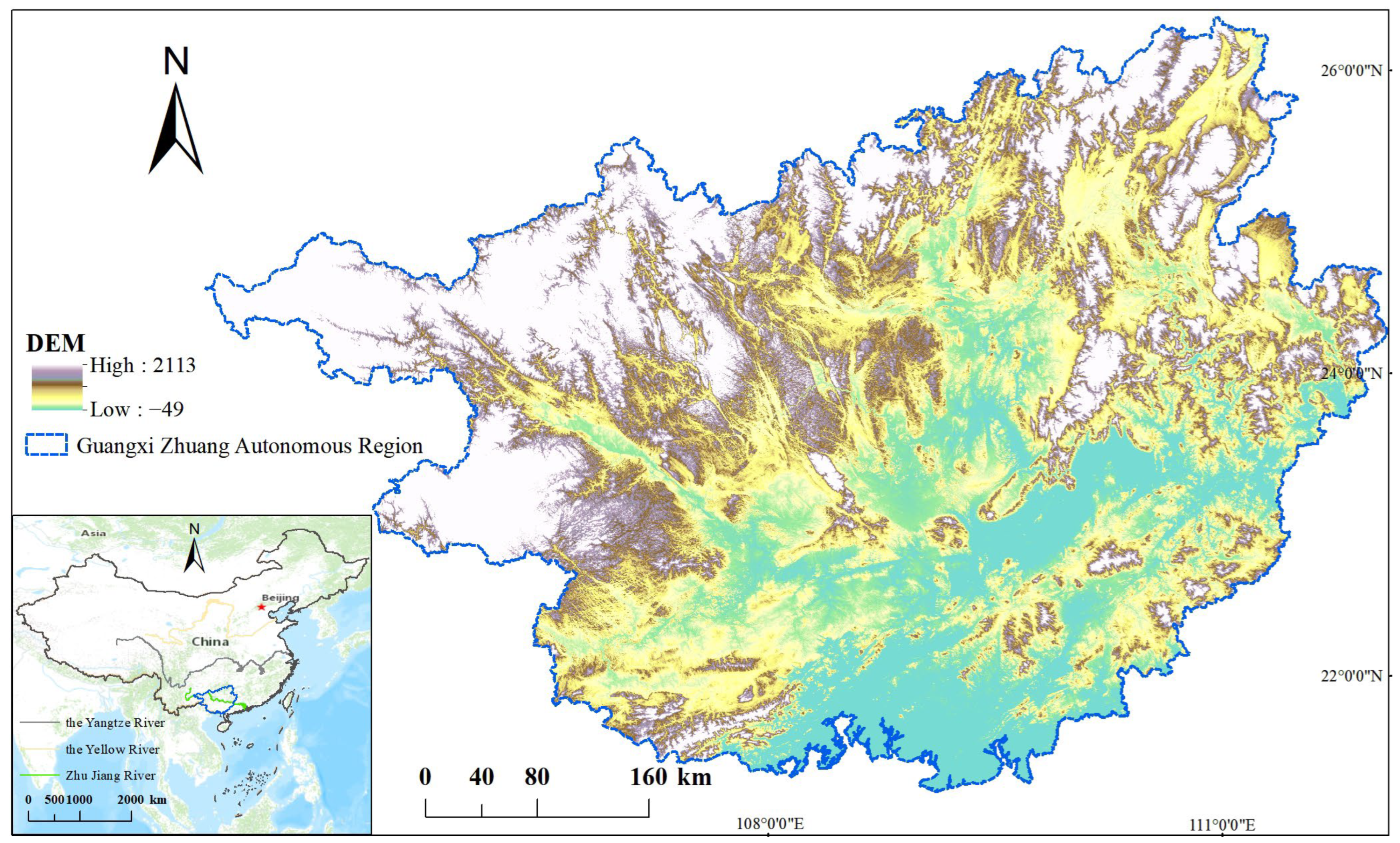
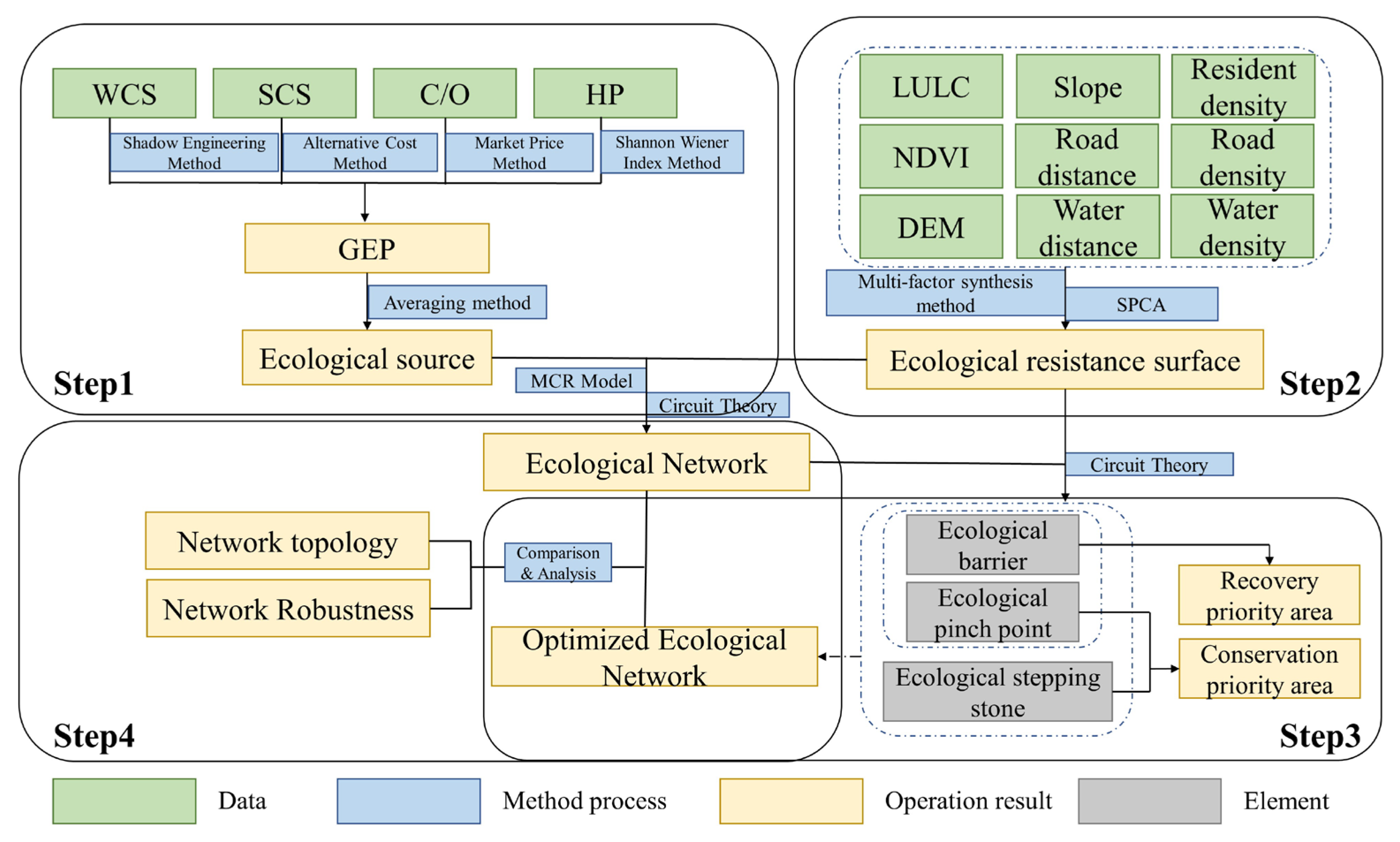
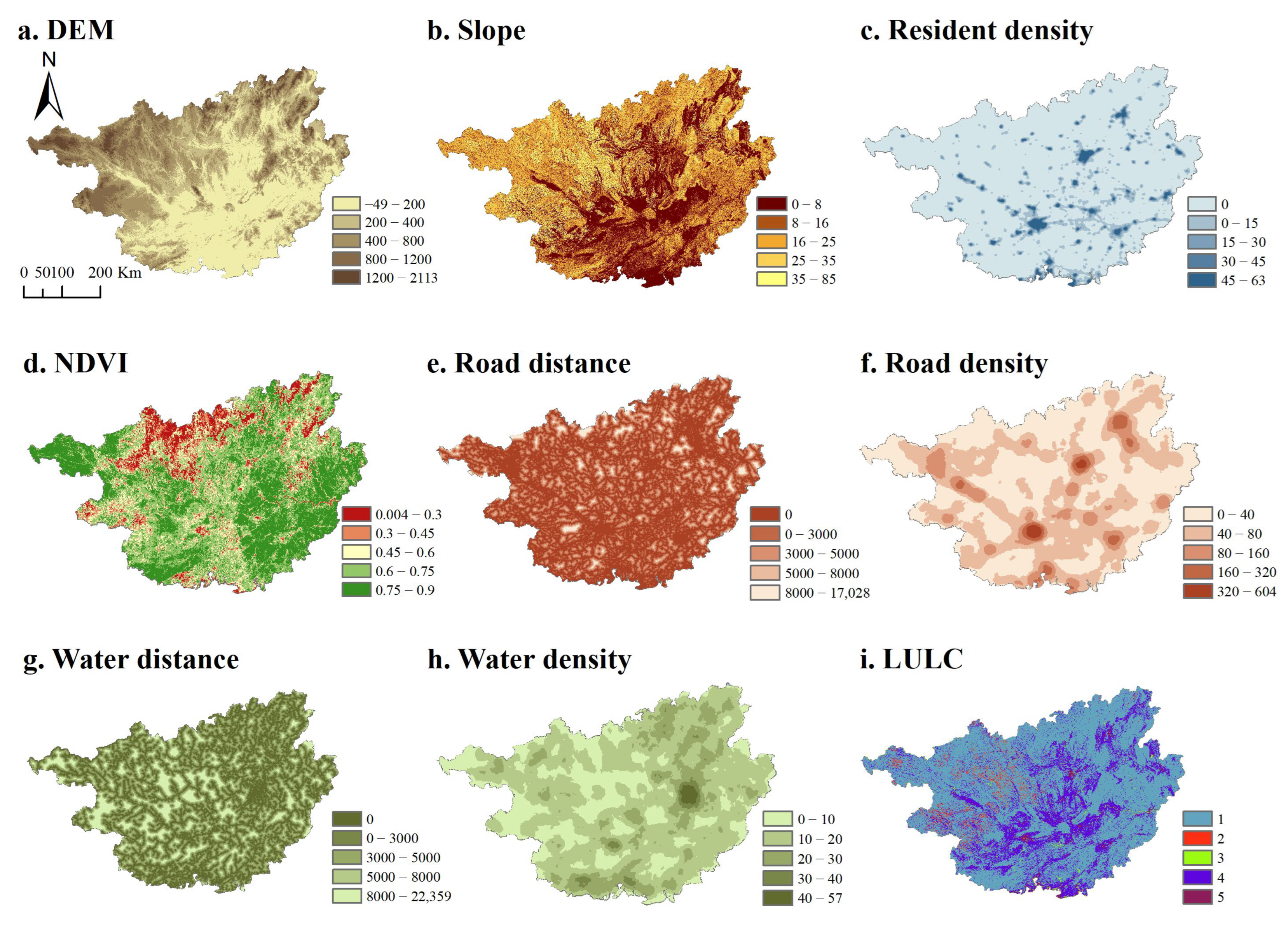

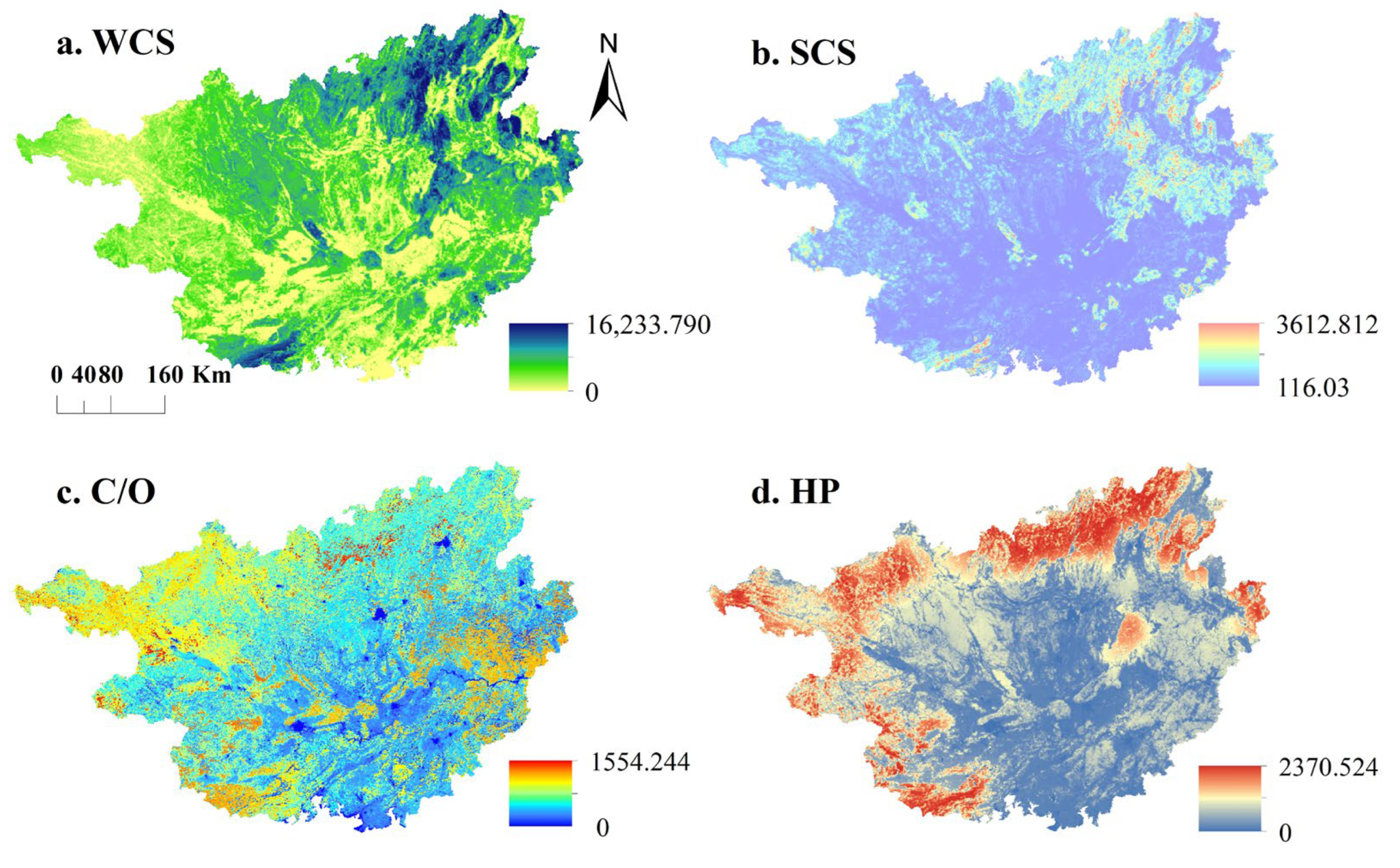


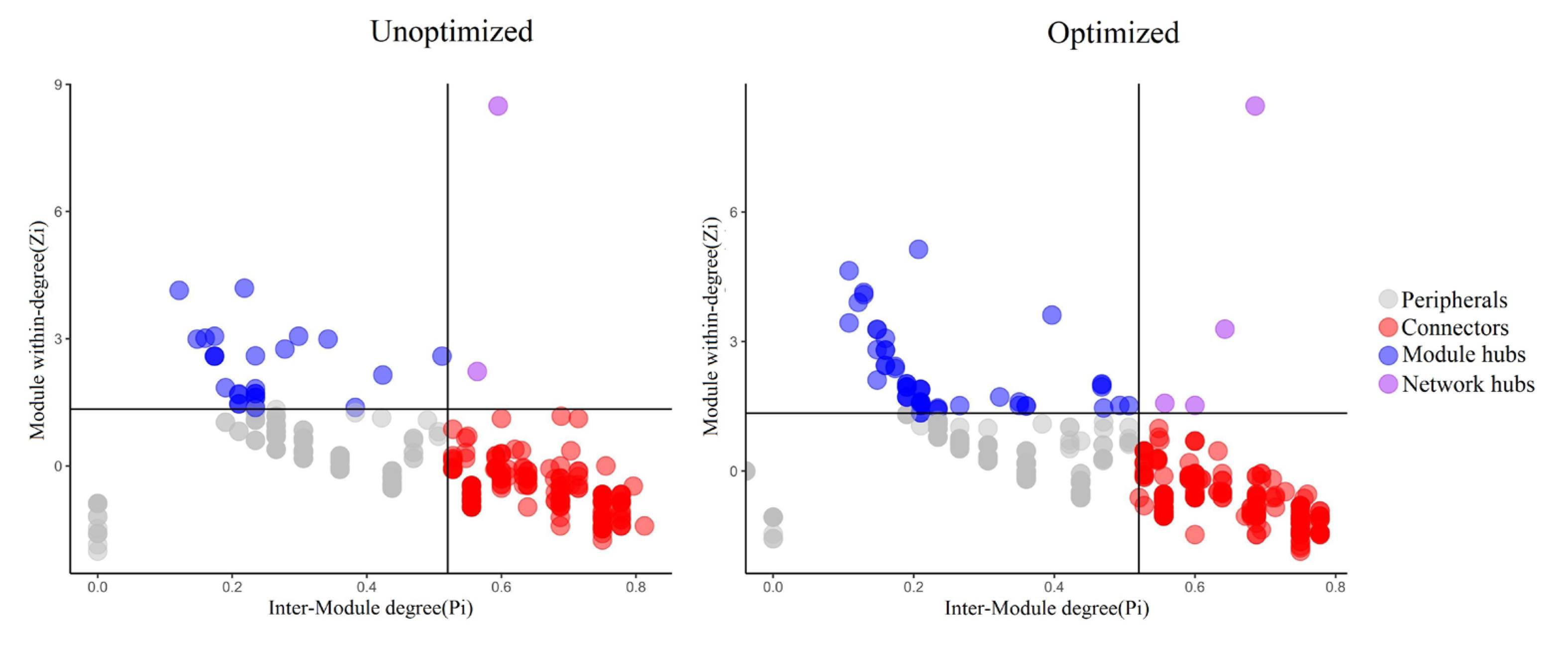
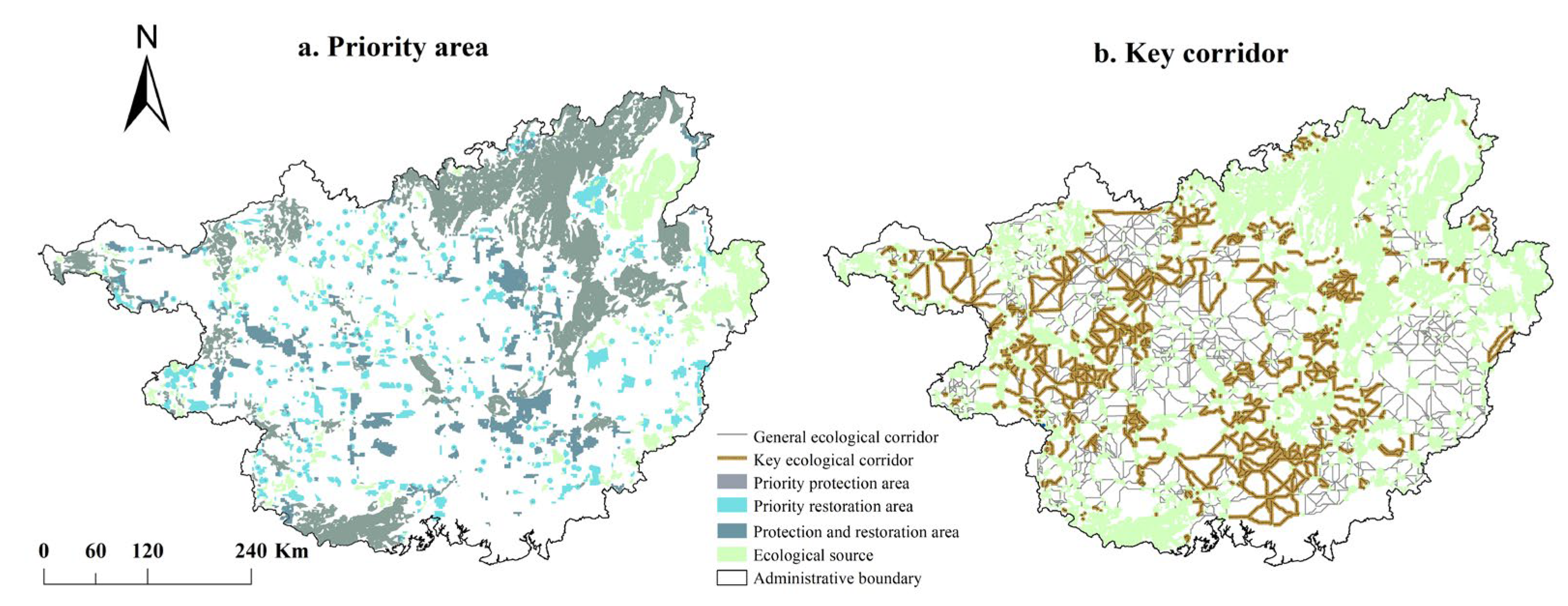
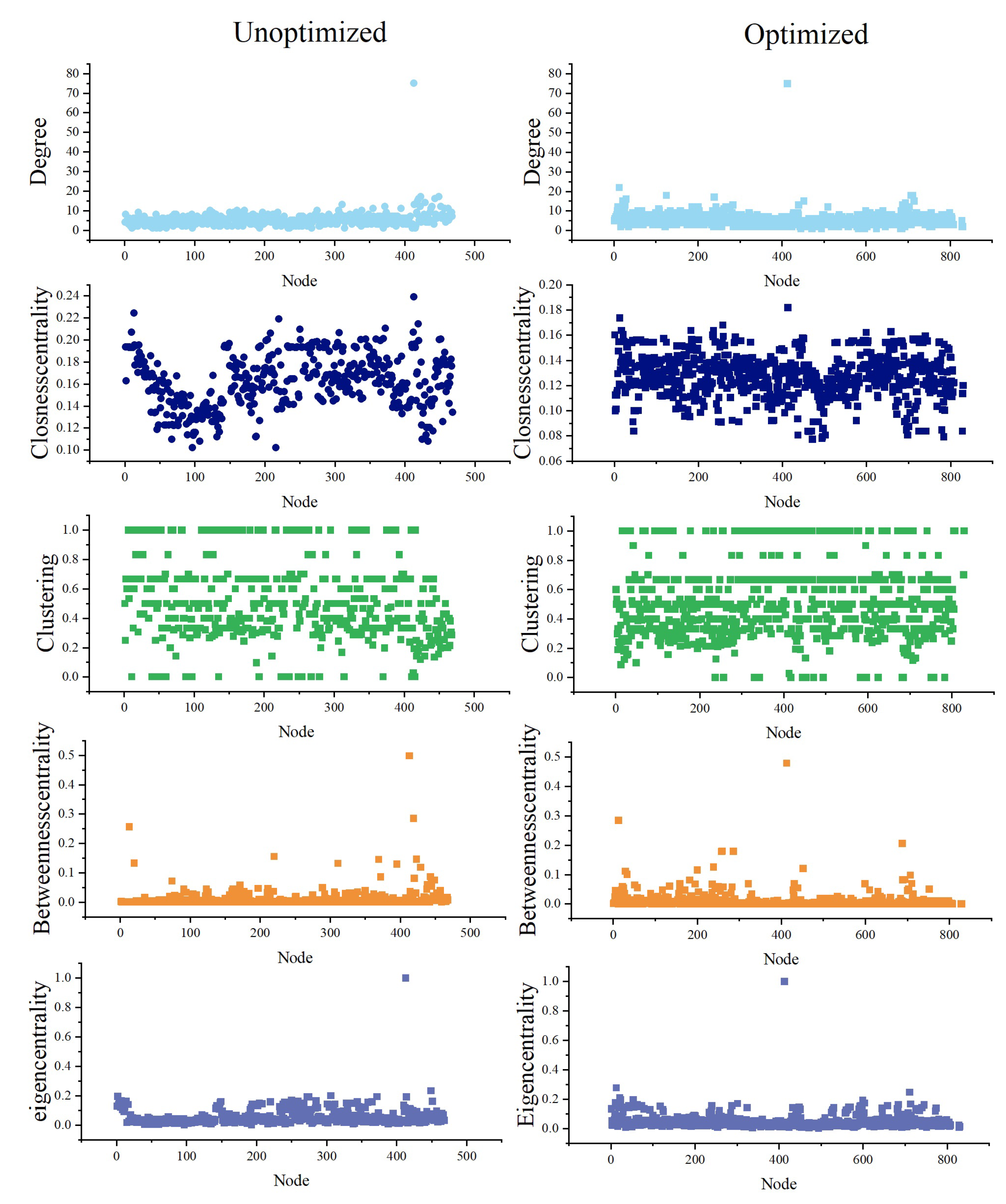
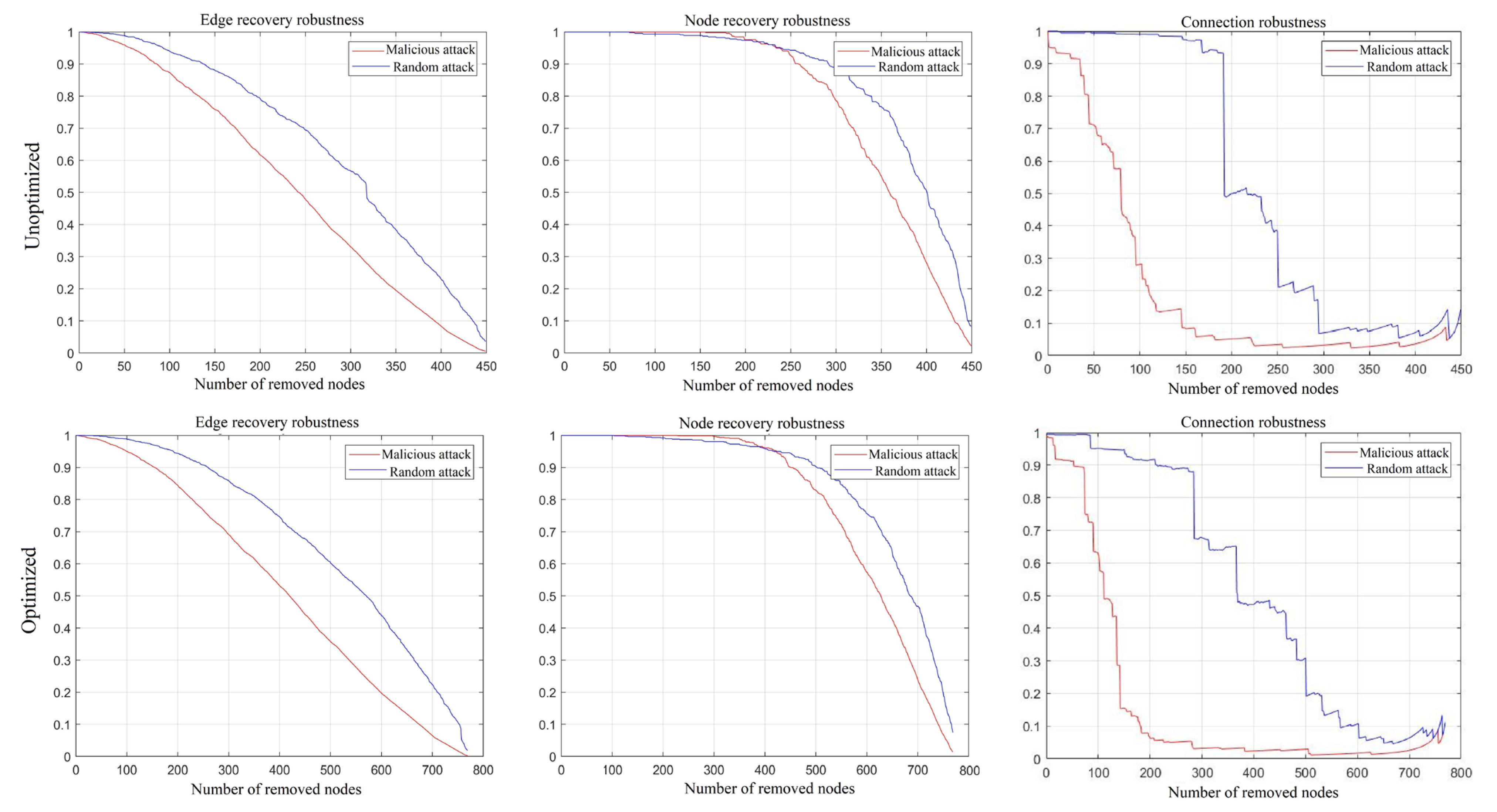
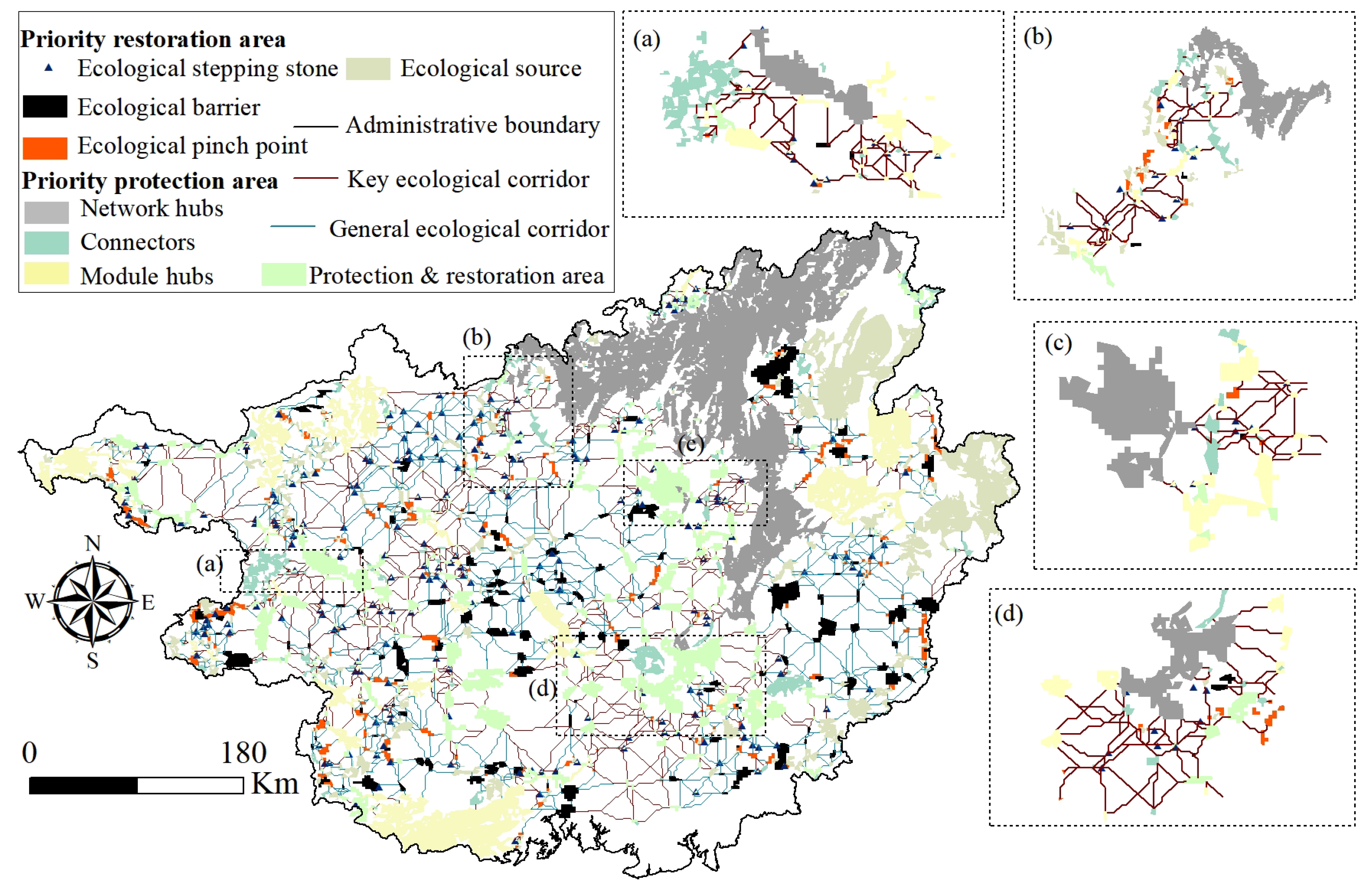
| Item | Describe | Biophysical Quantities | Method | Value Quantity | Method | Note |
|---|---|---|---|---|---|---|
| Water Conservation Service (WCS) | , annual evapotranspiration ()). | Water Balance Equation | Shadow engineering method | The ratio of the annual fixed investment in water conservancy in Guangxi to the reservoir construction capacity is taken as the price of the reservoir construction project. | ||
| Soil Conservation Service (SCS) | ) of vegetation by the quantitative model of soil loss | Universal Soil Loss Equation (USLE) | Replacement cost method | The ratio of the investment in comprehensive soil erosion control in the small watershed of Guangxi to the area of the soil erosion control is taken as the price of the soil erosion control project. | ||
| Carbon Sequestration and Oxygen Release Services (C/O) | ) and oxygen release () are calculated. | Remote sensing inversion, model simulation, and measured data | Market price method | Economic prices are carbon trading price and industrial oxygen price respectively. | ||
| Habitat Provision (HP) | Estimation of biological distribution quantity based on habitat quality and habitat scarcity () | Estimation of biological distribution quantity | Shannon–Wiener index grade | The conservation value of species per unit area is taken as the price. |
| Resistance Factor | 1 | 2 | 3 | 4 | 5 | Weight |
|---|---|---|---|---|---|---|
| DEM | −15–200 | 200–400 | 400–800 | 800–1200 | 1200–2113 | 0.056 |
| Slope | 0–8 | 8–16 | 16–25 | 25–35 | 35–85 | 0.045 |
| LULC | Forest | Grass/shrubs | Water | Cropland | Construction land | 0.320 |
| Residential density | 0 | 0–15 | 15–30 | 30–45 | 45–62 | 0.137 |
| Road distance (m) | 8000–17,000 | 5000–8000 | 3000–5000 | 0–3000 | 0 | 0.060 |
| Water distance (m) | 0 | 0–3000 | 3000–5000 | 5000–8000 | 8000–22,000 | 0.140 |
| Road density | 320–600 | 160–320 | 80–160 | 40–80 | 40 | 0.146 |
| Water density | 0.05–10 | 10–20 | 20–30 | 30–40 | 40–60 | 0.037 |
| NDVI | 0.75–0.9 | 0.6–0.75 | 0.45–0.6 | 0.3–0.45 | 0.05–0.3 | 0.094 |
| Topological Attribute | Calculation Method | Describe | Note |
|---|---|---|---|
| Average degree | The relationship between the number of patches (nodes) and the number of patches (edges) | is the average degree. is the number of patches. is the number of patch edges. | |
| Network diameter | ) | is the shortest distance from node to node . | |
| Clustering coefficient | The degree of interconnection between adjacent points of a point. | The clustering coefficient is the ratio of the actual number of edges between neighboring nodes of a node to the total number of possible edges. | |
| Eigenvector centrality | A measure of the transmission influence and connectivity between patches. | The center vector is the left eigenvector of the adjacency matrix associated with the eigenvalues . as the largest eigenvalue in the absolute value of the matrix . | |
| Betweenness centrality | The number of times a node acts as a bridge for the shortest path between the other two nodes. | represents the center of the number of nodes . is the shortest paths from node to node through node , and is the shortest path from node to node . | |
| Closeness centrality | Generally speaking, the distance between a transit patch and other patches is the shortest. | is the closeness centrality of node , and is used to calculate the number of direct connections between node () and other nodes. is the sum of the cell values of the corresponding rows or columns of nodes in the network matrix. |
| LULC | Unoptimized | Optimized | ||
|---|---|---|---|---|
| Area (km2) | Proportion (%) | Area (km2) | Proportion (%) | |
| Cropland | 1874.93 | 3.63 | 10,779.88 | 14.64 |
| Forest | 49,052.03 | 94.91 | 60,485.25 | 82.14 |
| Grassland | 571.71 | 1.11 | 1032.55 | 1.40 |
| Shrub | 34.94 | 0.07 | 56.21 | 0.08 |
| Water | 128.48 | 0.25 | 510.70 | 0.69 |
| Construction land | 22.45 | 0.04 | 774.59 | 1.05 |
| GEP | WCS | SCS | C/O | HP | ALL |
|---|---|---|---|---|---|
| Guangxi | 235.36 | 52.38 | 22.53 | 34.37 | 344.64 |
| Unoptimized ecological source | 99.05 | 26.60 | 5.34 | 13.51 | 144.50 |
| Optimized ecological source | 112.03 | 28.99 | 7.23 | 15.53 | 163.78 |
| Add ecological source | 12.98 | 2.39 | 1.89 | 2.02 | 19.27 |
| Modularity Index | Number of Nodes | Area (Km2) | WCS | SCS | C/O | HP | GEP (Billion USD) |
|---|---|---|---|---|---|---|---|
| Connectors | 285 | 8482.36 | 8.65 | 1.83 | 0.85 | 1.27 | 12.59 |
| Module hubs | 56 | 16,978.72 | 23.87 | 6.36 | 1.77 | 3.79 | 35.79 |
| Network hubs | 4 | 25,408.89 | 48.22 | 12.97 | 2.43 | 6.01 | 69.62 |
Disclaimer/Publisher’s Note: The statements, opinions and data contained in all publications are solely those of the individual author(s) and contributor(s) and not of MDPI and/or the editor(s). MDPI and/or the editor(s) disclaim responsibility for any injury to people or property resulting from any ideas, methods, instructions or products referred to in the content. |
© 2023 by the authors. Licensee MDPI, Basel, Switzerland. This article is an open access article distributed under the terms and conditions of the Creative Commons Attribution (CC BY) license (https://creativecommons.org/licenses/by/4.0/).
Share and Cite
Wang, L.; Wang, S.; Liang, X.; Jiang, X.; Wang, J.; Li, C.; Chang, S.; You, Y.; Su, K. How to Optimize High-Value GEP Areas to Identify Key Areas for Protection and Restoration: The Integration of Ecology and Complex Networks. Remote Sens. 2023, 15, 3420. https://doi.org/10.3390/rs15133420
Wang L, Wang S, Liang X, Jiang X, Wang J, Li C, Chang S, You Y, Su K. How to Optimize High-Value GEP Areas to Identify Key Areas for Protection and Restoration: The Integration of Ecology and Complex Networks. Remote Sensing. 2023; 15(13):3420. https://doi.org/10.3390/rs15133420
Chicago/Turabian StyleWang, Luying, Siyuan Wang, Xiaofei Liang, Xuebing Jiang, Jiping Wang, Chuang Li, Shihui Chang, Yongfa You, and Kai Su. 2023. "How to Optimize High-Value GEP Areas to Identify Key Areas for Protection and Restoration: The Integration of Ecology and Complex Networks" Remote Sensing 15, no. 13: 3420. https://doi.org/10.3390/rs15133420





